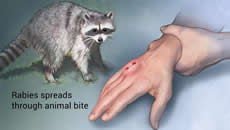Rabies
 |
Rabies is a deadly virus spread to people from the saliva of infected animals. Rabies is usually spread through an animal bite. Animals most likely to spread rabies include dogs, bats, coyotes, foxes, skunks and raccoons. |
Australia is one of the few countries in the world that does not have rabies. However, Australian bats carry other viruses in the lyssavirus family including Australian bat lyssavirus, which is closely related to rabies. While it’s very rare, you should assume that any bat in Australia could potentially carry the virus.
- Treatable by a medical professional
- Spreads by animals or insects
- Requires a medical diagnosis
- Lab tests or imaging always required
- Short-term: resolves within days to weeks
How it spreads
- By animal or insect bites or stings
Symptoms
Symptoms include fever, headache, excess salivation, muscle spasms, paralysis and mental confusion.
- Pain areas: in the muscles
- Whole body: dizziness, fatigue, fever, loss of appetite, or malaise
- Psychological: delirium, fear, or hallucination
- Gastrointestinal: nausea or vomiting
- Muscular: muscle spasms or paralysis with weak muscles
- Sensory: pins and needles or sensitivity to light
- Behavioural: aggression or irritability
- Also common: anxiety, brain death, coma, difficulty swallowing, dilated pupil, drooling, excess salivation, headache, mental confusion, seizures, or stiff neck
Treatment
Seek immediate medical attention after a bite or suspected bite. There is no specific treatment for rabies. Once symptoms appear, it’s nearly always fatal. A vaccine can prevent infection.
- Preventative:
- Rabies Vaccine: A vaccine that prevents rabies before or after an animal bite. Treatment must begin before symptoms appear.
- Medications:
- Blood transfusion: Blood components that are added to replace deficiencies within the bloodstream.
- Antiviral drug: Reduces viruses’ ability to replicate
- Medical procedure:
- Milwaukee protocol: An experimental treatment for rabies that puts the person into a deep sleep (coma) and then medicates them
- Specialists:
- Emergency Medicine Doctor: Treats patients in the emergency department
- Infectious Disease Doctor: Treats infections, including those that are tropical in nature
Rabies Vaccine
The Rabies vaccine (PDF file, 416.4 KB) is given to people at high risk of rabies to protect them if they are exposed. If can also prevent the disease if it is given to a person after they have been exposed. Rabies vaccine is made from killed rabies virus. It cannot cause rabies.
Pre-exposure prophylaxis (PreP)
The recommended schedule for PreP for rabies infection consists of a total of 3 doses of vaccine; the first dose of vaccine is given on day 0, and subsequent doses on days 7 and 21-28. Although the third dose can be given as early as 21 days, there is no data to support the use of an even more accelerated schedule for those with limited time before travel to a rabies-enzootic area.
Post-exposure prophylaxis (PEP)
In persons previously unvaccinated, the recommended schedule for PEP for immunocompetent persons consists of 4 doses of vaccine. The first dose of vaccine is given as soon as practicable (day 0), and subsequent doses are given on days 3, 7 and 14; deviations of a few days from this schedule are probably unimportant.
The recommended schedule for PEP for previously unvaccinated immunocompromised persons consists of 5 doses of vaccine. The first dose of vaccine is given as soon as practicable (day 0), and subsequent doses are given on days 3, 7, 14 and 28; deviations of a few days from this schedule are probably unimportant.
The recommended schedule for PEP for people who have been previously vaccinated against rabies consists of 2 doses of rabies vaccine on days 0 and 3.
Please let us know if you have ever had a serious (life-threatening) allergic reaction to a previous dose of rabies vaccine; or if you have a weakened immune system because of HIV/AIDS or anther disease that affects the immune system, treatment with drugs that affect the immune system (steroids), or cancer/cancer treatment with radiation or drugs. If you are moderately or severely ill, you should probably wait until you recover before getting a routine (non-exposure) dose of rabies vaccine.
Dosage and Administration
The dose of varicella vaccine is 1.0mL, to be given by intramuscular injection.
What do you have to do?
Book in to consult one of our Doctors today if you have any symptoms or if you would like the vaccine.